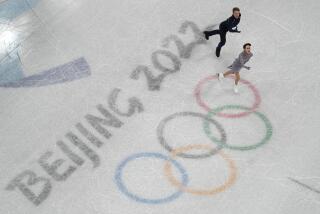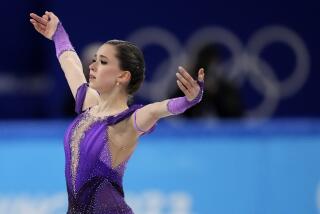Suit change doesn’t help U.S. men in Olympic speedskating
SOCHI, Russia — The suits showed up. The racers in them did not.
When U.S. speedskaters took the ice Saturday in the men’s 1,500 meters, they wore racing suits by Under Armour made for their successful World Cup season. Gone were the Mach 39 suits Under Armour debuted for these Games, the ones that had come to symbolize American futility.
But the day ended as every day in Sochi has since the opening ceremony: no U.S. skaters on the podium at Adler Arena.
Brian Hansen finished seventh and Shani Davis — who took silver in the 1,500 the last two Games — was 11th. Joey Mantia was 22nd and Jonathan Kuck, 37th. A disastrous Olympics for U.S. Speedskating, which has won more medals for the U.S. than any other winter sport, continues unabated.
FRAMEWORK: Best images from Sochi
“There were just so many things going on, with what’s going on with this, what’s going on with that, what’s got to happen here,” said Davis, 31. “I think if we could eliminate all those distractions and I could’ve just put that energy into performing and skating, it would’ve been a totally different outcome.”
The constant talk surrounding the Mach 39 did not help anyone connected to the team. After a meeting Friday that included 17 skaters and U.S. Speedskating coaches and staff, the team sought approval from the International Skating Union to use the old suits. That approval came very early Saturday in Sochi.
Hansen, 23, said he felt more excited and confident back in the older suit.
“It was a little tough for me to focus on what I was trying to do,” said Hansen, who clocked 1:45.59, a half-second behind winner Zbigniew Brodka of Poland.
Despite not medaling, Hansen was glad the swap of suits had been made.
“The other skin suit may still be the fastest skin suit in the world,” Hansen said. “But part of the problem is that we haven’t had the chance to race in it and have the results to know it’s the fastest skin suit in the world.”
For Davis, these Olympics changed after the 1,000, a race in which he was the heavy favorite, owns the world record and still calls himself the “king” of. He finished eighth, denying him from becoming the first American man to win the same event in three straight Winter Olympics.
“It almost sucked all the life out of me,” Davis said. “It was very hard to come back from that.”
Davis, the world’s top-ranked skater, said questions about potential design flaws in the new suit were first brought to him by a Dutch reporter. He said he later brought it up with U.S. Speedskating. The suit was not used in competition before the Olympics, a decision skaters say was made by U.S. Speedskating and Under Armour. If there is a problem with the suit, the time to fix it came and went during World Cup racing, Davis said.
“You can’t do that at the Olympics,” Davis said. “There’s too much riding on it.”
Dutch skater Mark Tuitert, the defending Olympic champion in the 1,500 who finished fifth Saturday, was more blunt: “It’s just plain stupid not to test the suits in a race before the Olympics.”
Just as the story of these Games has stayed the same for the U.S., so it goes for the dominant Dutch.
With Koen Verweij’s silver in the 1,500, the Netherlands grabbed its 13th speedskating medal of these Games, an Olympic record.
Dutch Coach Jillert Anema dismissed the idea that a racing suit could be entirely responsible for the United States’ slow times. But he agreed with Davis that if there were a problem, it should have been addressed ahead of arriving in Sochi.
“Skating is a feeling and you cannot allow yourself to have your feelings go down,” Anema said. “There is no one thing in skating. In skating, there is belief, there is feeling. It’s like a religion.”
Twitter: @jaredshopkins
More to Read
Get our high school sports newsletter
Prep Rally is devoted to the SoCal high school sports experience, bringing you scores, stories and a behind-the-scenes look at what makes prep sports so popular.
You may occasionally receive promotional content from the Los Angeles Times.






